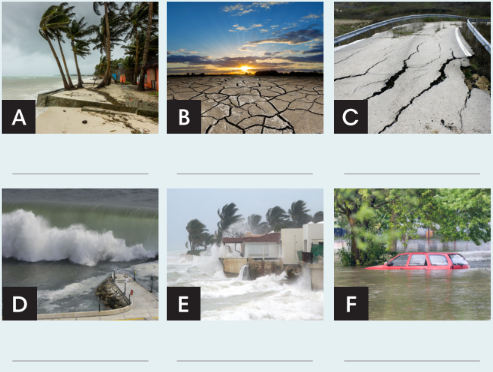Tiếng Anh 8 Unit 2 Vocabulary in action1. Write the words from the glossary under each picture. 2. Put the words given in the correct forms. 3. Listen and repeat. 4. Work in pairs. Complete the dialogues with the words given. Listen and check. Then practice. Quảng cáo
Lựa chọn câu để xem lời giải nhanh hơn
Bài 1 1. Write the words from the glossary under each picture. (Viết các từ trong danh mục từ vựng dưới mỗi bức tranh.)
Lời giải chi tiết: Picture A: stormy (Hình A: bão) Picture B: drought (Hình B: hạn hán) Picture C: earthquake (Hình C: trận động đất) Picture D: burst (Hình D: vỡ bờ) Picture E: hurricane (Hình E: cơn bão) Picture F: flood (Hình F: lũ lụt) Bài 2 2. Put the words given in the correct forms. (Đặt các từ được đưa ra trong các hình thức chính xác.) 1. Be careful with the _______ eruptions around this area. (VOLCANO) 2. Look! It’s _______ outside. We can’t drive our car in this weather. (FOG) 3. _______ is the most spectacular element of a thunderstorm. (LIGHT) 4. The tsunami’s effects are severe. The _______ rate in this region is low. (SURVIVE) Lời giải chi tiết:
1. Be careful with the volcanic eruptions around this area. (Hãy cẩn thận với những vụ phun trào núi lửa xung quanh khu vực này.) Giải thích: Trước danh từ “eruptions” cần tính từ. vocano (n): núi lửa => vocanic (adj): thuộc về núi lửa 2. Look! It’s foggy outside. We can’t drive our car in this weather. (Nhìn kìa! Bên ngoài có sương mù. Chúng tôi không thể lái xe của chúng tôi trong thời tiết này.) Giải thích: Sau động từ “is” cần tính từ. fog (n): sương mù => foggy (adj): có nhiều sương 3. Lighting is the most spectacular element of a thunderstorm. (Tia chớp là yếu tố ngoạn mục nhất của giông bão.) Giải thích: Trước động từ “is” cần danh từ số ít hoặc không đếm được để đóng vai trò chủ ngữ. light (n): ánh sáng => lightning (n): sấm chớp 4. The tsunami’s effects are severe. The survival rate in this region is low. (Ảnh hưởng của sóng thần rất nghiêm trọng. Tỷ lệ sống ở vùng này thấp.) Giải thích: Sau mạo từ “the” và trước danh từ “rate” cần tính từ hoặc danh từ để tạo thành cụm danh từ. survive (v): sống sót => survival (n): sự sống sót Bài 3 Stress in words ending in -oo, -oon, -ese, -eer, -ee. (Trọng âm ở những từ kết thúc bằng -oo, -oon, -ese, -eer, -ee.) 3. Listen and repeat. (Lắng nghe và lặp lại.) kangaroo, typhoon, Vietnamese, poineer, disagree Phương pháp giải: kangaroo /ˌkæŋɡəˈruː/ (n): chuột túi typhoon /taɪˈfuːn/ (n): bão nhiệt đới Vietnamese /ˌviːetnəˈmiːz/ (n): tiếng Việt/ người Việt poineer /ˌpaɪəˈnɪə(r)/ (n): người tiên phong disagree /ˌdɪsəˈɡriː/ (v): không đồng ý Bài 4 4. Work in pairs. Complete the dialogues with the words given. Listen and check. Then practice. (Làm việc theo cặp. Hoàn thành các đoạn đối thoại với các từ cho sẵn. Nghe và kiểm tra. Sau đó thực hành.)
1. A: Do you know the (1) ______ called Noru in Việt Nam? B: Yes, it affected many (2) ______ people living in the centre of Việt Nam. 2. A: I think the young (3) ______ in this (4) ______ company should (5) ______ in this project. B: I (6) ______. I think everyone should take part in this project. Lời giải chi tiết:
1. A: Do you know the typhoon called Noru in Việt Nam? (Bạn có biết cơn bão tên là Noru ở Việt Nam không?) B: Yes, it affected many Vietnamese people living in the centre of Việt Nam. (Vâng, nó đã ảnh hưởng đến nhiều người Việt Nam sống ở miền trung Việt Nam.) 2. A: I think the young pioneers in this Chinese company should volunteer in this project. (Tôi nghĩ những người tiên phong trẻ trong công ty Trung Quốc này nên tình nguyện tham gia dự án này.) B: I disagree. I think everyone should take part in this project. (Tôi không đồng ý. Tôi nghĩ mọi người nên tham gia vào dự án này.)
|




















